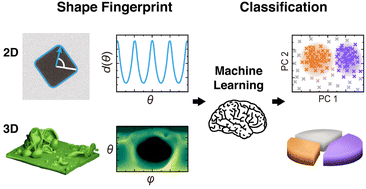Seeking regularity from irregularity: unveiling the synthesis–nanomorphology relationships of heterogeneous nanomaterials using unsupervised machine learning†
Abstract
Nanoscale morphology of functional materials determines their chemical and physical properties. However, despite increasing use of transmission electron microscopy (TEM) to directly image nanomorphology, it remains challenging to quantify the information embedded in TEM data sets, and to use nanomorphology to link synthesis and processing conditions to properties. We develop an automated, descriptor-free analysis workflow for TEM data that utilizes convolutional neural networks and unsupervised learning to quantify and classify nanomorphology, and thereby reveal synthesis–nanomorphology relationships in three different systems. While TEM records nanomorphology readily in two-dimensional (2D) images or three-dimensional (3D) tomograms, we advance the analysis of these images by identifying and applying a universal shape fingerprint function to characterize nanomorphology. After dimensionality reduction through principal component analysis, this function then serves as the input for morphology grouping through unsupervised learning. We demonstrate the wide applicability of our workflow to both 2D and 3D TEM data sets, and to both inorganic and organic nanomaterials, including tetrahedral gold nanoparticles mixed with irregularly shaped impurities, hybrid polymer-patched gold nanoprisms, and polyamide membranes with irregular and heterogeneous 3D crumple structures. In each of these systems, unsupervised nanomorphology grouping identifies both the diversity and the similarity of the nanomaterial across different synthesis conditions, revealing how synthetic parameters guide nanomorphology development. Our work opens possibilities for enhancing synthesis of nanomaterials through artificial intelligence and for understanding and controlling complex nanomorphology, both for 2D systems and in the far less explored case of 3D structures, such as those with embedded voids or hidden interfaces.

- This article is part of the themed collections: Nanoscale 2023 Emerging Investigators and Celebrating International Women’s Day: Women in Nanoscience


 Please wait while we load your content...
Please wait while we load your content...